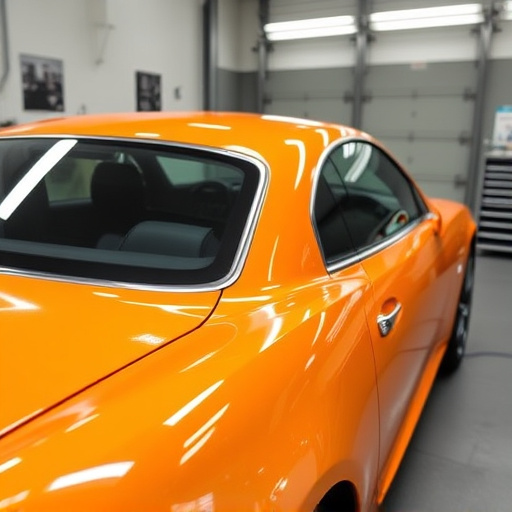Mastering Panel Blending: Tools and Techniques for Collision-Free Results

Panel blending in collision repair is an art of integrating replaced panels for structural integrity…….
In an era defined by rapid technological evolution, the concept of blending panels collision has emerged as a transformative force, reshaping industries and redefining interactions between physical and digital environments. This phenomenon involves the seamless integration of diverse panel systems, enabling them to interact, exchange data, and create novel experiences. By merging the capabilities of various technologies, from smart materials to interactive displays, blending panels collision offers endless possibilities for innovation across sectors such as architecture, urban planning, retail, and entertainment.
This article delves into the intricacies of blending panels collision, exploring its definition, global impact, economic implications, technological innovations, regulatory landscape, challenges, and future prospects. By examining these aspects, we aim to provide a holistic understanding of this dynamic field and equip readers with valuable insights for navigating its potential.
Definition:
Blending panels collision refers to the synergistic interaction between multiple panel systems, designed to seamlessly merge their functionalities. These panels can be composed of various materials and technologies, including but not limited to glass, plastic, metal, sensors, displays, and smart fabrics. The core principle lies in breaking down traditional silos between these components, enabling them to communicate and collaborate as a unified system.
Core Components:
Panels: The foundation of this concept, panels can be of various types, each with unique attributes. Examples include transparent LED panels, interactive touch screens, smart glass, and flexible displays.
Sensors and Actuators: These elements facilitate interaction and response by detecting user input or environmental changes. They may include motion sensors, touch sensors, temperature sensors, and actuators for controlling panel behavior.
Control Systems: The software and hardware that orchestrate the interaction between panels, enabling them to process data, make decisions, and execute commands. This includes microcontrollers, processors, and custom-built control algorithms.
Network Connectivity: Enabling panels to communicate with each other and external systems, ensuring data exchange and synchronization. Wireless technologies like Bluetooth, Wi-Fi, Zigbee, and cellular networks play a pivotal role here.
Historical Context:
The journey towards blending panels collision has been shaped by advancements in various fields over the past few decades. The development of smart materials, such as electrochromic glass and shape-memory alloys, laid the groundwork for interactive and responsive surfaces. Concurrently, progress in sensor technology and computer processing power enabled more sophisticated data collection and interpretation.
The early 2000s saw a surge in research focused on creating interactive displays and windows, marking a significant step towards blending panels. This period witnessed the emergence of touch-sensitive screens, gesture recognition systems, and the integration of display technologies with architectural structures.
Blending panels collision has captivated attention worldwide, driving innovation across diverse sectors. The global market for interactive displays and smart glass is expected to reach USD 31.5 billion by 2027, growing at a CAGR of 16.8% from 2020 to 2027 (MarketsandMarkets). This growth is fueled by:
Urbanization: Rapid urbanization in developing countries presents a vast opportunity for implementing blended panel systems in smart cities and metropolitan areas. Interactive displays can enhance public spaces, improve wayfinding, and provide dynamic advertising.
Retail and Entertainment: Retailers and entertainment venues are leveraging blending panels collision to create immersive shopping experiences, interactive product displays, and captivating storytelling environments.
Architecture and Construction: Architects and designers are exploring new forms of expression by integrating smart glass, LED panels, and other interactive elements into building facades, offering enhanced aesthetics and functionality.
Automotive Industry: The automotive sector is witnessing the rise of head-up displays (HUDs), augmented reality windshields, and advanced driver-assistance systems (ADAS) that rely heavily on blending panel technologies.
Regional Trends:
North America: Known for its technological prowess, North America leads in innovation related to blending panels collision, with a strong focus on research and development in smart glass and interactive displays. Companies like Microsoft and Intel have contributed significantly to this field.
Europe: Europe’s commitment to sustainability and energy efficiency drives the adoption of smart glass and dynamic window systems, reducing building energy consumption. Germany and the UK are notable hubs for smart building technologies.
Asia Pacific: Rapid urbanization in countries like China and India creates a massive market potential for interactive public displays and smart cities applications. Japan’s advanced robotics and electronics industries contribute to cutting-edge developments.
Latin America and Middle East & Africa: These regions are witnessing growing interest in blending panels collision for both commercial and residential projects, driven by modernization and the desire for unique architectural designs.
The economic implications of blending panels collision are profound, with significant market opportunities and growth drivers across various segments:
| Segment | Market Size (2021) | Growth Rate (2021-2027) | Key Drivers |
|---|---|---|---|
| Interactive Displays (Global) | USD 15.4 billion | 18.2% | Rising demand from retail, entertainment, and advertising sectors |
| Smart Glass (Global) | USD 3.2 billion | 21.7% | Increasing adoption in automotive, architecture, and consumer electronics |
| Augmented Reality Headsets (Global) | USD 6.5 billion | 29.8% | Growing popularity in gaming, education, and industrial applications |
Market Dynamics:
Vertical Integration: Many companies are adopting a vertical integration approach, controlling both hardware production and software development to ensure seamless compatibility and competitive edge.
Partnerships and Collaborations: Strategic partnerships between technology providers, panel manufacturers, and industry experts foster innovation, knowledge sharing, and access to diverse markets.
Customized Solutions: The ability to tailor blended panel systems to specific client needs is a significant advantage, enabling businesses to differentiate themselves in competitive markets.
Investment Patterns:
Venture Capital (VC) Investment: VC firms are actively investing in startups that offer innovative solutions in blending panels collision, recognizing the potential for disruptive technologies.
Government Grants and Incentives: Governments worldwide are providing financial support for research and development in smart cities, interactive displays, and related technologies, fostering local innovation ecosystems.
Corporate Investments: Major corporations across industries are investing heavily in blending panels collision to enhance their product offerings and create unique customer experiences.
The technological landscape of blending panels collision is characterized by rapid progress and groundbreaking innovations:
Flexible and Transparent Displays: The development of flexible OLED (Organic Light Emitting Diode) displays and transparent LED films allows for the creation of curved, bendable, and even see-through panels, opening doors to novel design possibilities.
Smart Materials: Advancements in smart glass technologies, electrochromic materials, and shape-memory alloys enable panels to adapt their properties in response to external stimuli, such as temperature, light, or electrical signals.
Haptic Feedback Systems: Integrating haptic technology with blended panel systems provides users with tactile feedback, enhancing interactivity and immersiveness, especially in virtual reality (VR) and augmented reality (AR) applications.
Edge Computing: Edge computing architectures enable real-time data processing at the edge of the network, reducing latency and improving responsiveness in interactive panel systems.
5G and Beyond: The rollout of 5G networks and future generations of wireless technology will facilitate faster data transfer rates and lower latency, enabling more complex and dynamic interactions between blended panels.
The rapid evolution of blending panels collision has prompted governments and regulatory bodies to establish frameworks that promote innovation while ensuring safety, privacy, and intellectual property protection. Key considerations include:
Safety Standards: Developing comprehensive safety standards for interactive displays, smart glass, and related technologies is crucial to mitigate potential health risks, especially regarding blue light exposure and electromagnetic radiation.
Privacy and Data Protection: With the collection and processing of user data, regulations like GDPR (General Data Protection Regulation) in Europe and similar laws worldwide ensure that personal information is handled securely and transparently.
Intellectual Property Rights: Establishing clear guidelines for patenting and licensing technologies related to blending panels collision encourages innovation while providing legal protections for developers and manufacturers.
Cybersecurity: As blended panel systems become more interconnected, addressing cybersecurity risks becomes critical. Standards and regulations should focus on securing communication protocols and data storage to prevent unauthorized access and system manipulation.
Despite its immense potential, blending panels collision faces several challenges and criticisms that require thoughtful solutions:
Initial Cost and Implementation: High initial costs for hardware and software can deter adoption, especially in smaller projects or developing markets. Streamlining implementation processes and offering flexible financing options can help overcome this hurdle.
Technical Complexity: Integrating multiple panel systems requires advanced technical expertise, which may be scarce in certain regions. Providing accessible training programs and establishing industry standards can address this challenge.
Energy Consumption: While smart glass and dynamic window systems offer energy efficiency benefits, the overall energy consumption of blended panel systems needs careful consideration, especially for large-scale deployments.
Privacy Concerns: The proliferation of interactive displays and cameras in public spaces raises privacy concerns. Implementing robust data protection measures and providing users with control over their personal information is essential.
Strategies for Overcoming Challenges:
Standardization: Developing industry standards for hardware interfaces, communication protocols, and software compatibility will simplify integration processes and reduce costs.
Public Education: Raising awareness about the benefits and responsible use of blending panels collision can foster public acceptance and address privacy concerns.
Government Incentives: Governments can play a pivotal role in promoting adoption by offering tax incentives, grants, or low-interest loans for projects incorporating blended panel technologies.
Collaborative Research: Encouraging partnerships between academia, industry, and government agencies can drive innovation, overcome technical barriers, and ensure the development of safe and reliable solutions.
Copenhagen’s street furniture, including bus stops and bike racks, has undergone a transformation with the integration of smart panels. These interactive displays provide real-time information on public transport, weather, and local events, enhancing the city’s overall user experience. The project achieved significant success by:
Engaging Local Businesses: Collaborating with businesses along the streets ensured community buy-in and provided revenue streams for maintaining the infrastructure.
Focusing on User Experience (UX): Prioritizing intuitive and user-friendly interfaces made the smart furniture accessible and appealing to diverse demographics.
Data-Driven Decisions: Analyzing user interactions revealed valuable insights, leading to improvements in the system’s functionality and relevance.
Nike’s flagship store in Manhattan utilized blending panels collision to create a unique shopping experience. Dynamic LED walls displayed product information and interactive displays allowed customers to customize shoes and apparel virtually. The success of this application lies in:
Personalized Shopping: By leveraging blended panels, Nike offered a highly personalized experience, engaging customers with their preferred products and styles.
Dynamic Content Delivery: The ability to update content in real-time kept the displays fresh and relevant, maintaining customer interest over extended periods.
Enhanced Brand Engagement: Interactive elements fostered a deeper connection with the brand, encouraging customers to spend more time in-store and explore additional products.
The Louvre introduced an AR application that brought historical artifacts to life for visitors. By scanning specific exhibits with their smartphones, users accessed interactive 3D models and immersive multimedia content. This case study highlights:
Educational Value: The AR experience provided a unique educational tool, offering insights into the history and craftsmanship behind famous artworks.
Accessibility: Users with diverse abilities could engage with the exhibits, ensuring inclusivity in the museum’s offerings.
Technological Adoption: The Louvre’s successful implementation demonstrated the potential for museums worldwide to embrace technology, enhancing visitor experiences while preserving cultural heritage.
The future of blending panels collision holds immense promise across various sectors, with emerging trends shaping its evolution:
Metaverse Integration: As the metaverse gains traction, blending panels collision will play a pivotal role in creating immersive virtual environments, interactive avatars, and dynamic digital landscapes.
5G and Beyond Connectivity: The rollout of advanced wireless networks will enable ultra-low latency communication, facilitating real-time interactions between blended panels in smart cities, automotive systems, and healthcare applications.
Sustainable Focus: With a growing emphasis on sustainability, future developments will prioritize energy-efficient panel technologies, recycled materials, and design strategies that minimize environmental impact.
Personalized Environments: From smart homes to adaptive public spaces, blending panels collision will enable personalized environments, catering to individual preferences and needs in real time.
Blending panels collision represents a powerful convergence of technology, design, and human interaction, offering endless possibilities for innovation and improvement across industries. By understanding its fundamentals, global impact, economic implications, technological advancements, policy considerations, challenges, and successful applications, we can harness its potential fully.
As we look ahead, the future of blending panels collision is bright, with emerging trends poised to revolutionize our physical and digital environments. Through continued research, strategic partnerships, and thoughtful regulations, this field will continue to shape our world, making it smarter, more interactive, and responsive to our needs. The journey has just begun, and together, we are writing the next chapter in the story of blending panels collision.
Q: What is the difference between blended panel systems and traditional displays?
A: Blended panel systems go beyond conventional displays by integrating multiple technologies (sensors, actuators, software) to create interactive, adaptive, and context-aware environments. Traditional displays primarily focus on showing visual content without these advanced capabilities.
Q: How do smart glass technologies work?
A: Smart glass uses electrochromic or liquid crystal materials that can change their opacity or color in response to electrical signals. By controlling the amount of light passing through, smart glass can transition from transparent to opaque or display patterns and images.
Q: What are some common applications of augmented reality (AR) in blending panels collision?
A: AR is widely used for interactive museum exhibits, gaming experiences, product visualization in retail, and training simulations. By overlaying digital content onto the real world, AR enhances user engagement and provides valuable information in an immersive manner.
Q: How can governments encourage the adoption of blending panels collision technology?
A: Governments can foster adoption through incentives like tax breaks, grants, and low-interest loans for businesses implementing blended panel technologies. Establishing safety and privacy standards, providing public education, and collaborating with industry experts also contribute to a supportive environment.
Q: What are the potential privacy risks associated with interactive displays?
A: Interactive displays may collect sensitive user data, including biometric information and browsing habits. Implementing robust data protection measures, such as encryption and anonymization techniques, is crucial to safeguard user privacy and maintain public trust.

Panel blending in collision repair is an art of integrating replaced panels for structural integrity…….

Blending panels is a specialized collision repair technique for precise color and texture matching i…….

Panel blending is a crucial, skilled technique vital for restoring luxury vehicles like Mercedes-Ben…….

Achieving precise color match during blending panels is critical in automotive repair, especially fo…….

Modern auto painting techniques require meticulous blending of metallic, pearl, and tri-coat finishe…….

Blending panels is a vital skill in collision repair, ensuring structural integrity and aesthetic ap…….

Achieving seamless panel blending in collision repair demands a solid grasp of color theory fundamen…….

Blending panels is a critical process in collision repairs, ensuring structural integrity and restor…….

Blending panels collision repairs is a specialized skill ensuring seamless integration of replacemen…….

Blending panels is a critical process in auto body collision repairs for luxury vehicles, ensuring p…….